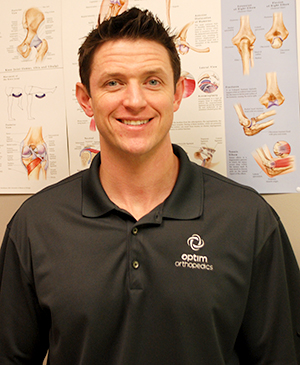New knee or hip can give you a new outlook on life
Orthopedics
A painful hip or knee can take the joy out of life. Maybe you find yourself avoiding the tennis court or golf course. Does walking up just a few stairs cause unbearable pain?
It may be time to consider a knee or hip replacement.
Knee and hip replacements are fairly common procedures. Most often they are performed due to arthritis or injury which causes pain, decreased motion of the joint or an inability to do every day activities.

A knee replacement restores the worn surfaces by removing diseased bone-ends and resurfacing them with a combination of metal and plastic components.
"The knee is a more complex joint than the hip," says Dr. Jonathan Christy, total joint surgeon with Optim Orthopedics.
Hip replacements also restore worn surfaces by removing the diseased bone-ends and resurface them with a combination or metal, plastic or ceramic components.
A new knee or hip allows a natural, gliding motion of the joint and can help relieve pain.
Whether you are scheduled for a hip or knee replacement or want to try to avoid one in the future, here are some things you should know.
How painful are the surgeries?
Advancements in technology, anesthesia and pain medications have helped reduced the pain level of joint replacement surgery over the years.
“Very rarely is someone going to look back on the experience and say they were a 10 out of a 10 on a pain scale,” Christy says. “But, they’re not going to tell you they were in no pain. It’s very tolerable.”
Expect to stay overnight following surgery
Christy keeps his joint replacement surgery patients overnight so staff can monitor their vital signs and check blood circulation. The joint replacement field is advancing quickly, and there are some instances where patients can go home on the same day as surgery, depending on the patient's health and what insurance requires.
Also expect physical therapy to start immediately – at least for knee replacement
Christy says knee replacement patients should expect physical therapy the same day that their surgery is performed. Physical therapy typically consists of walking and a series of exercises with the assistance of a physical therapist.
Physical therapy will optimize recovery and daily movement, so it’s important for patients to stick with their physician’s and therapist’s recommended physical, and sometimes occupational, therapy routines. Therapy can continue for a month to six weeks, Christy says, and then patients are weaned back into a gym routine or home exercise program.
For hip replacement patients, Christy does not send them to physical therapy. He says walking is the best thing for those patients.
It may take a few weeks but you will feel like a new person following joint replacement surgery
You’ve tolerated the pain. You’ve made it through physical therapy. Chances are you are feeling like a new person who is again enjoying an active, comfortable lifestyle.
Length of recovery varies from person to person depending on one’s health and lifestyle. Hip replacement patients typically heal faster than knee replacement ones.
“I routinely have my patients back on tennis courts and golfing within four to six weeks,” Christy says. “Most of my patients once they get to the six week or two month mark will comment they wish they would have done it years ago.
"The only thing we ask that you limit is running, but outside of that limitation there are no restrictions in recreational activities."
Are there other options to joint replacement surgery?
Former athletes, those with arthritis, someone who had previous traumas or the obese may be prone to need hip or knee replacements. However, Christy says you cannot predict who will need joint replacement at some point in their lifetime.
There are options to joint replacement surgery, and there are several things you can do to try to avoid it.
Joint replacement surgery is typically a last-resort measure to rid one of knee or hip pain. Arthritis and pain-management medications are available, as well as injections, such as cortisone, and anti-inflammatories. Other options include arthroscopy and cartilage regeneration.
If you are feeling pain in the hip or knee, Christy advises not to ignore it.
“At least have it evaluated,” he says. “It could be something like a meniscus tear that may be amenable to an outpatient arthroscopy or scope and not necessarily a joint replacement.”
If you want to try to avoid future knee and hip pain, Christy says to get active and stay active. Yes it may sound counterintuitive, but an active lifestyle also correlates with a healthy weight, which has a huge impact on your joints.
“Weight destroys your joints,” Christy says. “Being obese with an elevated BMI really predisposes you to arthritis.”
Christy recommends regular, low-impact exercises, avoid running and follow a healthy diet. If you do run or start to experience soreness in your joints, Christy says anti-inflammatories, ice therapy and the supplement glucosamine chondroitin may assist with pain.
For more information on joint replacement surgery and to learn about the St. Joseph’s/Candler Institute for Advanced Bone and Joint Surgery, click here.